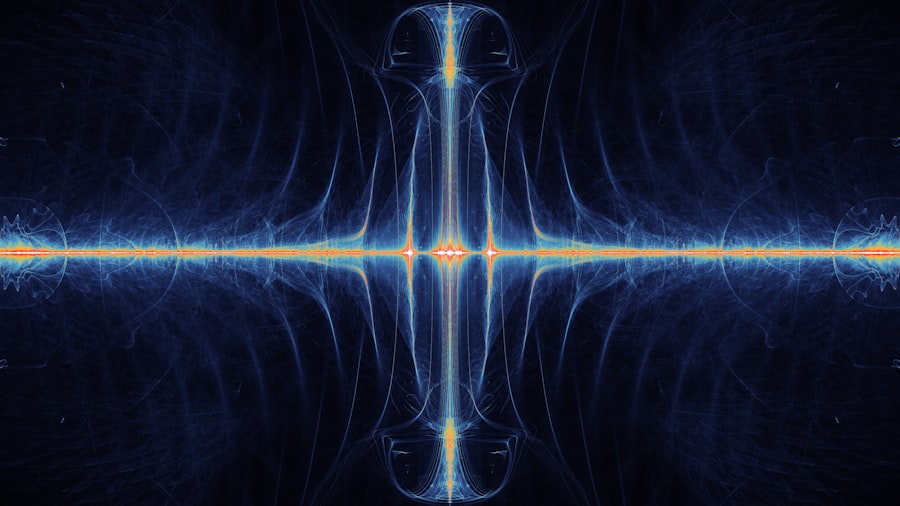As you delve into the fascinating world of brain rhythms, you may find yourself captivated by theta rhythms, a unique oscillatory pattern that plays a crucial role in various cognitive functions. These brain waves, typically ranging from 4 to 8 Hz, are not just mere electrical signals; they are integral to how you process information, form memories, and navigate your environment. Understanding theta rhythms can provide you with insights into the intricate workings of your mind and how it interacts with the world around you.
Theta rhythms have garnered significant attention in neuroscience due to their association with states of relaxation, creativity, and deep meditation. When you experience moments of deep focus or daydreaming, theta waves are often at play. This article will explore the multifaceted nature of theta rhythms, their relationship with memory and navigation, and their implications for cognitive enhancement and understanding brain disorders.
Key Takeaways
- Theta rhythms play a crucial role in memory formation and spatial navigation
- These rhythms are measured and recorded using electroencephalography (EEG) and other neuroimaging techniques
- The medial temporal lobe is a key brain region involved in generating theta rhythms
- Understanding theta rhythms has implications for understanding and treating brain disorders
- Current research is focused on harnessing theta rhythms for cognitive enhancement and potential therapeutic interventions
The Role of the Medial Temporal Lobe in Memory and Navigation
The medial temporal lobe (MTL) is a critical region of your brain that plays a pivotal role in memory formation and spatial navigation. Located deep within the temporal lobe, this area houses structures such as the hippocampus and the entorhinal cortex, which are essential for encoding and retrieving memories. When you recall a past event or navigate through familiar surroundings, it is the MTL that orchestrates these complex processes.
As you engage in activities that require memory recall or spatial awareness, the MTL becomes highly active. This region not only helps you remember facts and experiences but also allows you to create mental maps of your environment. The interplay between the MTL and theta rhythms is particularly intriguing, as research suggests that these oscillations may facilitate communication between different brain regions involved in memory and navigation.
What are Theta Rhythms?

Theta rhythms are a specific type of brain wave characterized by their frequency range of 4 to 8 Hz. You might encounter these oscillations during various states of consciousness, including light sleep, relaxation, and focused attention. Unlike faster brain waves associated with alertness and cognitive processing, theta waves are often linked to a more introspective state of mind.
When you find yourself in a meditative state or engaged in creative thinking, theta rhythms may dominate your brain activity. These oscillations are not merely passive; they actively influence cognitive processes. Research has shown that theta rhythms can enhance synaptic plasticity, which is crucial for learning and memory formation.
As you explore the depths of your cognitive abilities, understanding theta rhythms can provide valuable insights into how your brain functions during different mental states.
The Importance of Theta Rhythms in Cognitive Function
| Theta Rhythms in Cognitive Function | Importance |
|---|---|
| Enhanced Memory | Theta rhythms have been linked to memory formation and retrieval. |
| Attention and Focus | Theta rhythms play a role in sustaining attention and focus during cognitive tasks. |
| Learning and Problem Solving | Theta rhythms are associated with learning new information and solving complex problems. |
| Emotional Regulation | Theta rhythms may contribute to emotional regulation and stress management. |
Theta rhythms play a vital role in various cognitive functions beyond memory formation.
When you engage in tasks that require innovative thinking or emotional processing, theta waves can help facilitate these complex cognitive activities.
The ability to tap into theta rhythms may enhance your overall cognitive flexibility, allowing you to approach challenges from different angles. Moreover, theta rhythms have been linked to improved focus and concentration. When you enter a state of deep concentration or flow, theta waves often become more pronounced.
This suggests that harnessing theta rhythms could be a key to unlocking your full cognitive potential. By understanding how these oscillations influence your mental processes, you can develop strategies to enhance your cognitive performance in various aspects of life.
How Theta Rhythms are Measured and Recorded
To study theta rhythms and their effects on cognitive function, researchers employ various techniques to measure and record brain activity. One of the most common methods is electroencephalography (EEG), which involves placing electrodes on your scalp to detect electrical activity in the brain. Through EEG recordings, scientists can identify the presence and amplitude of theta waves during different mental states.
In addition to EEG, other imaging techniques such as functional magnetic resonance imaging (fMRI) can provide insights into the neural correlates of theta rhythms. While fMRI measures blood flow in the brain, it can help researchers understand how different regions interact during tasks that involve theta oscillations. By combining these methods, scientists can gain a comprehensive understanding of how theta rhythms manifest in your brain and their implications for cognitive function.
The Relationship Between Theta Rhythms and Memory Formation

The relationship between theta rhythms and memory formation is one of the most extensively studied areas in neuroscience. When you learn new information or experiences, theta waves are believed to play a crucial role in encoding these memories. Research has shown that increased theta activity in the hippocampus correlates with successful memory formation.
This suggests that when you engage in learning activities that promote theta oscillations, you may enhance your ability to retain information. Furthermore, theta rhythms are thought to facilitate communication between the hippocampus and other brain regions involved in memory processing. This synchronization allows for the integration of new information with existing knowledge, creating a more robust memory network.
As you explore techniques to improve your memory retention, understanding the role of theta rhythms can provide valuable insights into optimizing your learning strategies.
Theta Rhythms and Spatial Navigation
Spatial navigation is another area where theta rhythms demonstrate their significance. When you navigate through your environment—whether it’s finding your way around a new city or recalling the layout of your home—theta waves are actively involved in this process. Research has shown that theta oscillations in the hippocampus are closely linked to spatial learning and memory.
As you move through space, your brain creates a mental map of your surroundings, allowing you to orient yourself effectively. Theta rhythms help facilitate this mapping process by enhancing synaptic plasticity within the hippocampus. This means that when you engage in activities that require spatial navigation, such as playing video games or exploring new places, tapping into theta rhythms may improve your navigational skills.
The Neural Mechanisms Underlying Theta Rhythms in the Medial Temporal Lobe
The neural mechanisms underlying theta rhythms in the medial temporal lobe are complex and multifaceted. Within this region, specific neuronal circuits generate theta oscillations through synchronized activity among excitatory and inhibitory neurons. When you engage in tasks that require memory or navigation, these circuits become activated, leading to the generation of theta waves.
Moreover, neurotransmitters such as acetylcholine play a crucial role in modulating theta activity. When you experience heightened arousal or attention, acetylcholine levels increase, promoting theta oscillations in the hippocampus. Understanding these neural mechanisms can provide valuable insights into how theta rhythms influence cognitive processes and how they may be targeted for therapeutic interventions.
The Implications of Theta Rhythms for Understanding Brain Disorders
The study of theta rhythms has significant implications for understanding various brain disorders. Abnormalities in theta oscillations have been linked to conditions such as Alzheimer’s disease, schizophrenia, and attention deficit hyperactivity disorder (ADHD). When you consider how these disorders impact cognitive function and memory processing, it becomes clear that investigating theta rhythms could lead to new therapeutic approaches.
For instance, researchers are exploring whether enhancing theta activity through non-invasive brain stimulation techniques could improve cognitive function in individuals with neurodegenerative diseases. By targeting the neural circuits responsible for generating theta rhythms, it may be possible to mitigate some of the cognitive deficits associated with these disorders.
Current Research and Future Directions in Understanding Theta Rhythms
Current research on theta rhythms is rapidly evolving, with scientists exploring new avenues for understanding their role in cognition and behavior. One promising area of investigation involves examining how lifestyle factors—such as sleep quality, exercise, and mindfulness practices—affect theta activity in the brain. As you consider ways to enhance your cognitive function, staying informed about these developments can help you make informed choices about your mental well-being.
Future directions in this field may also include exploring the potential for harnessing theta rhythms for cognitive enhancement through targeted interventions. Techniques such as neurofeedback training could allow individuals to learn how to modulate their own theta activity consciously. By gaining control over these oscillations, you may unlock new levels of creativity, focus, and memory retention.
The Potential for Harnessing Theta Rhythms for Cognitive Enhancement
In conclusion, theta rhythms represent a fascinating aspect of brain function with profound implications for memory formation, spatial navigation, and overall cognitive performance. As you explore the intricate relationship between these oscillations and various cognitive processes, it becomes evident that understanding theta rhythms could pave the way for innovative approaches to enhancing mental capabilities. By harnessing the power of theta rhythms through lifestyle changes or targeted interventions, you may unlock new pathways for cognitive enhancement.
Whether through mindfulness practices that promote relaxation or engaging in activities that stimulate theta activity during learning experiences, there is immense potential for optimizing your cognitive function. As research continues to unfold in this exciting field, staying informed about developments related to theta rhythms can empower you to take charge of your cognitive health and well-being.
Theta rhythms in the medial temporal lobe have been a focal point of research due to their association with memory and navigation. A related article that delves deeper into the implications of these rhythms can be found at this link. This article explores the role of theta oscillations in cognitive processes and their potential impact on understanding various neurological conditions.
WATCH THIS! Déjà Vu Is a GLITCH in the Matrix: Your Brain’s Worst Error Explained
FAQs
What are theta rhythms in the medial temporal lobe?
Theta rhythms are a type of brain wave pattern that occurs in the medial temporal lobe of the brain. They are typically observed during states of arousal, such as when an individual is engaged in active exploration or navigation.
What is the function of theta rhythms in the medial temporal lobe?
Theta rhythms are believed to play a role in various cognitive functions, including spatial navigation, memory formation, and decision-making. They are thought to coordinate the activity of different brain regions involved in these processes.
How are theta rhythms in the medial temporal lobe measured?
Theta rhythms can be measured using electroencephalography (EEG), which records the electrical activity of the brain. In animal studies, researchers can also use microelectrode recordings to directly measure theta rhythms in the medial temporal lobe.
What factors can influence theta rhythms in the medial temporal lobe?
Theta rhythms can be influenced by various factors, including the individual’s level of arousal, the specific task being performed, and the presence of certain neurotransmitters in the brain. Additionally, disruptions in theta rhythms have been associated with certain neurological and psychiatric disorders.
What are the potential implications of studying theta rhythms in the medial temporal lobe?
Studying theta rhythms in the medial temporal lobe can provide insights into the neural mechanisms underlying spatial navigation, memory formation, and decision-making. This research may have implications for understanding and treating conditions such as Alzheimer’s disease, epilepsy, and other cognitive disorders.
